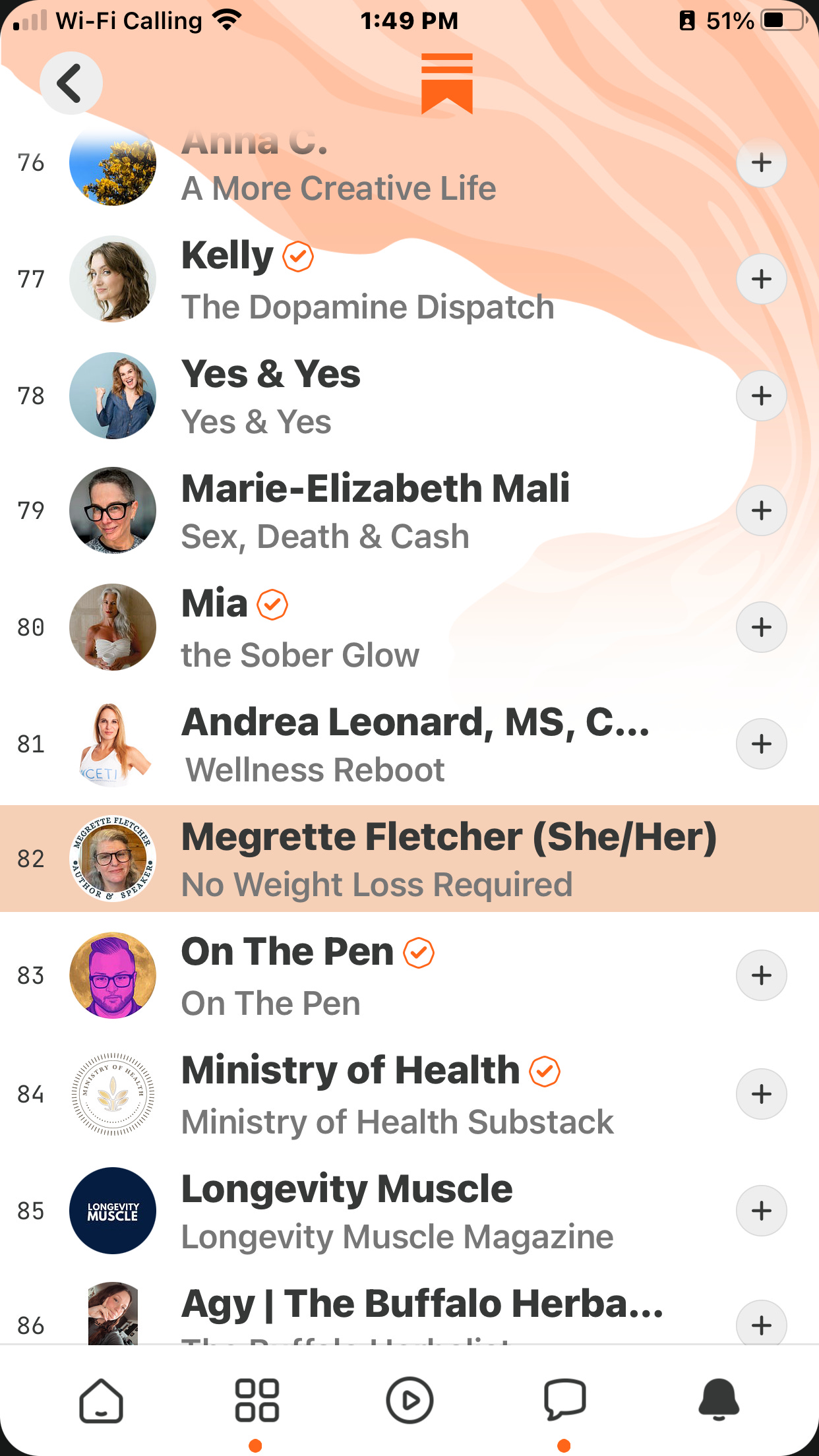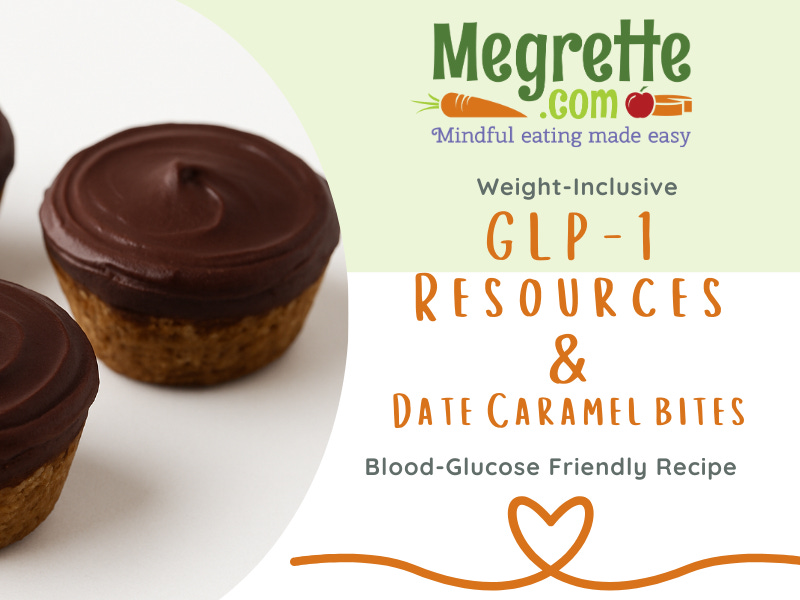Seven Things You Need To Know When Considering GLP-1s
My list (seven and counting) of things I see as a weight-inclusive RD about GLP-1s that may surprise you. I included a non-biased factsheet and my delicious date caramel recipe
Happy mid-July, everyone! Not much is happening personally, except the countdown to my summer vacation! A couple of folks reached out because they can’t book a session with me. I’m not accepting new clients at Nourish; however, I have some magic powers, and I can open up some slots if you would like to work with me 1:1. You can message me at Substack or email me at megrette.fletcher@usenourish.com.
I did get a surge of joy this month, despite battling a 6-day migraine, which is no easy feat. My only paid newsletter, No Weight Loss Required, rose to #82 on the Best Sellers Marquee. Go me!
As a weight-inclusive dietitian and diabetes educator, there is a lot of information trying to persuade you either for or against GLP1s. Unfortunately, this adds to the confusion, which is why I created an ebook about GLP-1s. You can purchase this for $7.99, or join No Weight Loss Required for $8.00 and receive it for free, along with all the other perks that come with this newsletter, which you can explore here.
Here is what I see when folks take GLP-1s.
Regardless of whether you are taking this medication for blood glucose or weight management, the following quote by the Swiss Physician, Paracelsus, in 1538 also applies to GLP-1s.
All things are poison, and nothing is without poison; the dosage alone makes it so a thing is not a poison.
If you have been dieting A LOT before taking GLP1, you may be surprised that you need to eat MORE. I know that feels weird, but most of my clients have to focus on eating, rather than not eating. Even with this medication, you still need to fuel your body.
Allocate time. I think this part is also a massive surprise for my clients. They decide to start a GLP1, and soon realize they also need to meal plan, go shopping, and have snacks!
Multiply your motivation to cook and meal prep. If it was hard before, it’s harder when you have no appetite or you are feeling nauseous.
Your grab-and-go diet likely wasn’t balanced. You may be shocked to learn that the RDA for protein is 60 grams, or 20 grams per meal, and when you are taking a GLP1, your protein needs increase.
Allocate even more time so you can exercise. This part isn’t new, but it is pretty scary to realize that without exercise, including strength training, up to 40% of the weight lost can be muscle.
Consider getting therapy. Going on a GLP1 can change your life, sometimes in ways that can feel unbalancing. It takes support, courage, and a lot of compassion to give yourself permission to engage in self-care, set boundaries, and untangle yourself from weight stigma.
Side Note: A weight-inclusive approach also means that you, not the diet, are the one giving permission to make these changes. This can feel weird, especially when a flood of emotions follows for seemingly no reason. (Psst! There is a reason and stepping into your agency and autonomy is often unfamiliar, AKA, scary.)
Starting a GLP1 can be a family affair. Family food conversations can sometimes be tricky. Children don’t understand why you would take a medication that makes you feel sick, or why you might not be eating. They may be curious why you eat differently from the family, or why you think you need to change. (They love you, just the way you are, so why don’t you?)
Here is my concern: if you aren’t careful, kids can hear a message that suggests they can only love themselves if they look/weigh a specific weight, which plants the seeds for their relationship with food, eating, and their body to be strained later in life. Parenting Without Dieting is a weight-inclusive newsletter by Oona Hanson.
Please keep reading to learn some facts about GLP-1s, and if you are in the mood, check out my last newsletter, which included a sassy quiz about GLP-1s.
As promised, here are my much-loved Date Carmel Chocolate Bites. My stepson is a bit of a foodie, and he often turns his nose up when I am in the kitchen; however, not only did he eat some, but he also asked to bring some home! (I was on cloud nine!) I was stunned that I didn’t take a picture of them, which is why there is an AI-created image of how they might look if I were a pastry chef.
Unbiased Facts about GLP1s:
What are GLP-1 medications?
GLP-1 receptor agonists are medications that mimic gut hormones. They are used for type 2 diabetes, prediabetes (off-label), and weight-related health concerns. They help:
Lower blood glucose after meals
Reduce appetite and slow digestion
Improve insulin signaling (especially in the liver and muscles)
Decrease food preoccupation (“food noise”)
Are there benefits without weight loss?
Improved insulin sensitivity: Helps muscles and liver respond better to insulin, reducing fatigue and blood sugar spikes.
Blood glucose reduction: Most users with type 2 diabetes see A1C drops of 1.5–2.2%.
Reduced food preoccupation: Many people experience fewer intrusive food thoughts, which may support more mindful eating.
Appetite regulation: Can reduce chaotic eating patterns.
Lower cardiometabolic risk: Independent of weight loss, GLP-1s have been shown to lower blood pressure, inflammation, and protect kidney function.
Less joint pain: Possibly due to lower inflammation and increased activity.
New entry point for behavior change: For those exhausted by diet culture, GLP-1s can offer a reset, not a fix.
What are the risks and concerns? Especially for people with a history of restriction or disordered eating?
Under eating and malnutrition: A suppressed appetite can lead to fatigue, nutrient deficiencies, and muscle loss, especially when protein intake is too low.
Loss of lean mass: Up to 25–40% of weight loss may be from muscle, which can slow metabolism and reduce strength.
Focusing only on weight change: Pressure specifically from healthcare professionals to focus solely on weight can foster distrust in the healthcare professional, especially if the client is experiencing physical or emotional side effects.
Disconnection from body cues: Low hunger may reinforce distrust of the body, triggering or worsening disordered eating.
GI side effects: Nausea, constipation, bloating, and fatigue affect up to 74% of users.
Mental health concerns: Some report increased anxiety, body image distress, or emotional blunting; rare reports of suicidal thoughts are under FDA review.
Social withdrawal: Consuming less food can reduce food enjoyment and hinder social connection and cultural participation.
Weight regain after stopping: Up to 50% of the weight may return within a year. This is a physiological response, not a personal failure; however, it can be emotionally challenging and trigger feelings of shame.
Reinforced weight stigma: Insurance often requires documentation of "diet failure," compounding stigma and unequal access.
Cost and access barriers: Most GLP-1s cost $900–$1300/month without insurance.
What happens when people stop using GLP-1 medications?
Blood sugar and weight often rise again. These changes are due to biological processes (reduced GLP-1 signaling, metabolic adaptation), not a lack of discipline.
Muscle loss may persist. Without consistent strength training and protein intake, it’s harder to regain strength and metabolic function.
Internalized shame may surface. Especially if weight returns and people feel they’ve “failed” despite doing nothing wrong.






This is great, Megrette. I have found the same things in regards to how people feel on these meds (emotionally and physically). Sadly, many doctors seem clueless about how these work (they think the point is to decrease eating alone), and aren't referring to an RD often enough when prescribing which they really need to do to prevent malnutrition! I'm more comfortable with their use in diabetes management than weight loss, but people are going to use them for that regardless of how I feel about it so my goal has been harm reduction and focusing on enough food, which of course is hard to determine when hunger cues are blunted. Thanks for this post!